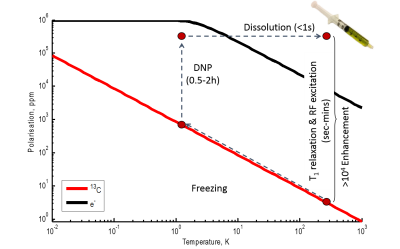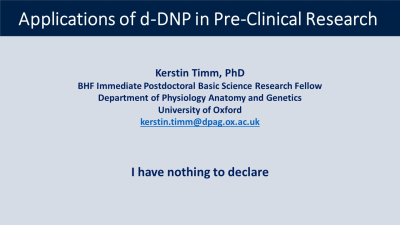Hyperpolarized MR Spectroscopic Imaging
Hyperpolarized MR Spectroscopic Imaging
Weekend Course
Weekend Course
ORGANIZERS: Yi-Fen Yen, Catherine Hines, Damian Tyler, Malgorzata Marjanska
Saturday, 11 May 2019
| Room 513A-C | 13:30 - 16:40 | Moderators: Matthew Rosen |
Skill Level: Basic to Intermediate
Session Number: WE-11
Overview
This course will introduce the techniques and in vivo applications of optical pumping, dynamic nuclear polarization, and parahydrogen-based hyperpolarization methods. Lectures will cover the fundamental principles, hardware, experimental set up, acquisition strategies, and research study designs.
Target Audience
Physicists, engineers, and clinical scientists interested in the nuts and bolts of hyperpolarized MR spectroscopic imaging, in vivo applications, and potential for clinical translation.
Educational Objectives
As a result of attending this course, participants should be able to:
- Categorize three basic hyperpolarization techniques;
- Name major hardware required for a hyperpolarized MRSI study;
- Describe basic MRSI methods; and
- Design a hyperpolarized MRSI animal study.
Overview
This course will introduce the techniques and in vivo applications of optical pumping, dynamic nuclear polarization, and parahydrogen-based hyperpolarization methods. Lectures will cover the fundamental principles, hardware, experimental set up, acquisition strategies, and research study designs.
Target Audience
Physicists, engineers, and clinical scientists interested in the nuts and bolts of hyperpolarized MR spectroscopic imaging, in vivo applications, and potential for clinical translation.
Educational Objectives
As a result of attending this course, participants should be able to:
- Categorize three basic hyperpolarization techniques;
- Name major hardware required for a hyperpolarized MRSI study;
- Describe basic MRSI methods; and
- Design a hyperpolarized MRSI animal study.
| 13:30 |
Get the Hype: The Physical Bases of Dynamic Nuclear Polarization for Medical Uses Video Permission Withheld
Lucio Frydman
This talk will discuss the physical basis of the DNP NMR/MRI experiment. Attention will focus on alternatives to do the hyperpolarization component in either solutions or in the solid state, focusing in particular on the Overhauser, on the Solid and on the Cross Effects for the sake of maximizing the nuclear polarization. The parameters that each of these methods requires to work best –including their respective advantages and drawbacks– will be explained. On the basis of this, the procedures that may then enable their respective utilization in bioimaging settings will be introduced
|
|
| 13:50 |
 |
Physics & Chemistry of d-DNP for Biomedical Imaging Video Permission Withheld
Mikko Kettunen
Dissolution dynamic nuclear polarisation (d-DNP) method allows hyperpolarisation of a broad range of molecules, yielding >10,000-fold increase in 13C signal-to-noise ratio. Hyperpolarisation is achieved through microwave-induced polarisation transfer from electrons to nuclei at solid-state followed by rapid dissolution. d-DNP places some limitations to suitable marker molecules, however. In this talk, the basics of d-DNP and chemistry involved will be discussed.
|
| 14:10 |
MR/MRSI Acquisition Strategies
Angus Lau
Dynamic nuclear polarization and dissolution offer the exciting possibility of imaging biochemical reactions in vivo, including some of the key enzymatic reactions involved in cellular metabolism. For MR metabolic imaging using 13C-labeled compounds and DNP, the desired information lies in both the spectral domain, with the relative amplitudes of the different chemical shift species, as well as in the spatial domain. This necessitates some form of spectral encoding together with the acquisition of imaging data, which strongly influences the design of pulse sequences for this application. We will discuss how to efficiently use the limited available hyperpolarized magnetization in conjunction with available imaging pulse sequences.
|
|
| 14:30 |
 |
Applications of d-DNP in Pre-Clinical Research
Kerstin Timm
Dissolution dynamic nuclear polarization (d-DNP) has made possible the in vivo measurements of biochemical reactions using MR spectroscopy and different imaging strategies. This presentation will focus on the available pre-clinical models used for d-DNP as well as a range of hyperpolarized 13C-labelled substrates that have been employed thus far. The talk will furthermore outline the necessary steps that have to be taken when planning pre-clinical d-DNP studies, ranging from the choice of model system over practical considerations to the actual hyperpolarized probes and their chemical modifications. The presentation will conclude by pointing towards potential future applications and optimizations of d-DNP.
|
| 14:50 |
Break & Meet the Teachers | |
| 15:20 |
PHIP & SABRE Techniques
Thomas Theis
Parahydrogen Induced Polarization (PHIP) is a relatively new hyperpolarization technique, first described in 1986. PHIP has advanced to enable important applications including biomolecular imaging with hyperpolarized MRI markers. Compared to other hyperpolarization techniques, PHIP is particularly simple and easy to implement but also faces critical challenges that still need to be addressed for widespread use. In this tutorial, insight into fundamental PHIP spin physics is given and it will be illustrated how such fundamental insight can drive innovation towards broader adaption of the technology in medical applications.
|
|
| 15:40 |
Imaging Applications of PHIP & SABRE Video Permission Withheld
Meghan Halse
In this presentation, the latest developments towards imaging applications of parahydrogen-based hyperpolarisation methods will be discussed. Recent advances of both the hydrogenative parahydrogen-induced polarisation (PHIP) and non-hydrogenative signal amplification by reversible exchange (SABRE) methods will be explored. In particular the talk will focus on developments in key aspects of clinical relevance including the optimisation of hyperpolarisation levels and lifetimes, strategies for increasing the range of agents amenable to hyperpolarisation, and developments that will allow for the delivery of biocompatible agents including both the solvent conditions and the removal of the transition metal catalyst.
|
|
| 16:00 |
SEOP & MEOP
Boyd Goodson
Once limited to the realm of fundamental physics experiments, hyperpolarized (HP) noble gases have been exploited to enhance magnetic resonance signals for a wide range of applications, including biomedical and clinical imaging. The purpose of this tutorial is to introduce the principles and practice of the primary methods of preparing hyperpolarized noble gases: spin-exchange optical pumping (SEOP) and metastability-exchange optical pumping (MEOP). Alternative approaches (e.g. dynamic nuclear polarization, DNP), will also be discussed.
|
|
| 16:20 |
Hyperpolarized Gas Imaging - A Focus on Ventilation
Jason Woods, Laura Walkup, David Roach, Matt Willmering, Zackary Cleveland
Hyperpolarized-gas MRI has seen a steadily increasing, albeit tortuous, path toward relevance in pulmonary medicine. During the last 10 years, the field has seen an increased focus on 129Xe, which can be used to measure regional ventilation, to characterize the size of alveolar spaces (diffusion MRI), and to measure gas exchange between the airspaces, red blood cells, and interstitium/plasma. This presentation will focus on ventilation imaging and the relevance of ventilation imaging to sensitive detection of early, regional lung obstruction. Application to well-characterized patient populations has allowed detailed comparisons of hyperpolarized-gas MRI to clinically-accepted techniques, demonstrating high sensitivity.
|
|
| 16:40 |
Adjournment & Meet the Teachers |
 Back to Program-at-a-Glance |
Back to Program-at-a-Glance |  Back to Top
Back to Top